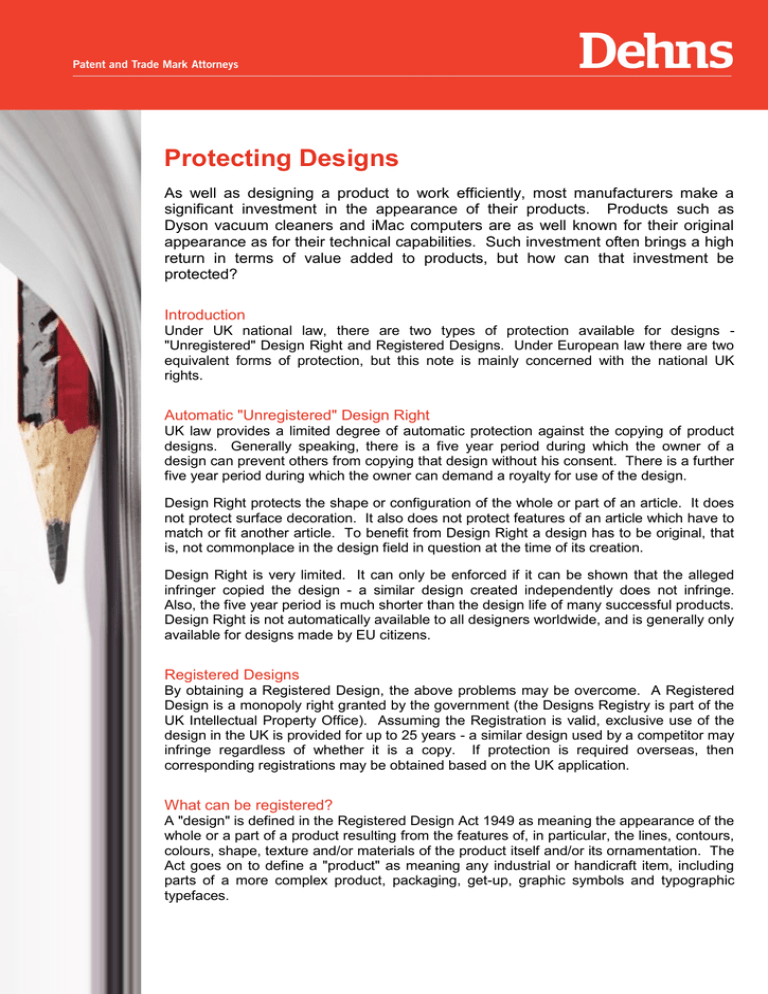Protecting Designs
advertisement

Protecting Designs As well as designing a product to work efficiently, most manufacturers make a significant investment in the appearance of their products. Products such as Dyson vacuum cleaners and iMac computers are as well known for their original appearance as for their technical capabilities. Such investment often brings a high return in terms of value added to products, but how can that investment be protected? Introduction Under UK national law, there are two types of protection available for designs "Unregistered" Design Right and Registered Designs. Under European law there are two equivalent forms of protection, but this note is mainly concerned with the national UK rights. Automatic "Unregistered" Design Right UK law provides a limited degree of automatic protection against the copying of product designs. Generally speaking, there is a five year period during which the owner of a design can prevent others from copying that design without his consent. There is a further five year period during which the owner can demand a royalty for use of the design. Design Right protects the shape or configuration of the whole or part of an article. It does not protect surface decoration. It also does not protect features of an article which have to match or fit another article. To benefit from Design Right a design has to be original, that is, not commonplace in the design field in question at the time of its creation. Design Right is very limited. It can only be enforced if it can be shown that the alleged infringer copied the design - a similar design created independently does not infringe. Also, the five year period is much shorter than the design life of many successful products. Design Right is not automatically available to all designers worldwide, and is generally only available for designs made by EU citizens. Registered Designs By obtaining a Registered Design, the above problems may be overcome. A Registered Design is a monopoly right granted by the government (the Designs Registry is part of the UK Intellectual Property Office). Assuming the Registration is valid, exclusive use of the design in the UK is provided for up to 25 years - a similar design used by a competitor may infringe regardless of whether it is a copy. If protection is required overseas, then corresponding registrations may be obtained based on the UK application. What can be registered? A "design" is defined in the Registered Design Act 1949 as meaning the appearance of the whole or a part of a product resulting from the features of, in particular, the lines, contours, colours, shape, texture and/or materials of the product itself and/or its ornamentation. The Act goes on to define a "product" as meaning any industrial or handicraft item, including parts of a more complex product, packaging, get-up, graphic symbols and typographic typefaces. These definitions make Registered Design protection available for a wide range of designs. As well as protecting the designs of three dimensional products and of patterns for which registered design protection has traditionally been obtained, it is possible to protect items such as logos, computer icons and fictional (e.g. cartoon) characters. In many cases therefore both design and trade mark registrations will be available for the same thing. It will be possible to protect the appearance of part of a product, such as the handle of a mug or the lid of a pen. What is needed? To register a design an application is made to the UK IPO giving details of the design usually in the form of drawings or photographs. It is also necessary to indicate what sort of product the design relates to and it is sometimes appropriate to give an indication of what features of the design are considered to be new. Novelty To be valid, the design must be new. In general, that means it must not have been disclosed anywhere in the world before the application is filed, although there are certain exceptions. Disclosures by the designer himself do not count if they are within a year prior to the application date. However, in case design protection may be required in other countries which do not have this exception, the safest course is to keep any design secret until an application to register it has been filed. Examination There are no official searches or novelty examination, but there is examination for basic formal requirements. Registration, and hence publication, of the design is expected to occur within a few weeks of filing. What to do next Unfortunately, although the basic concept of design registration is simple, the law relating to it is rather complex. As a result, the foregoing is only a very brief and approximate indication of how the system works. Whilst there is no legal requirement that applicants for Registered Designs be represented, we would recommend that advice be sought from a Patent or Trade Mark Attorney. Professional advice should also be considered if a new product is to be launched so that the risk of infringing someone else's rights can be considered. Further advice If you would like any further advice please contact us at Dehns using the details below. Copyright 2010. The information in this document is necessarily of a general nature and is given by way of guidance only. Specific legal advice should be sought on any particular matter. Dehns accepts no responsibility whatsoever for any action taken or not taken on the basis of the information contained herein. (Last updated January 2010 - AJP)
